172 Classon Avenue
Brooklyn, NY 11205
USA
Join us at e-flux Screening Room on Tuesday, May 17 at 7pm for an evening of shorts by Maryam Tafakory introduced by the artist; and on Thursday, May 19 at 7pm for an evening with Su Friedrich, featuring a selection of Friedrich’s films and a conversation with the filmmaker.
Tickets are available here.
Tuesday, May 17, 7pm
An Evening of Shorts by Maryam Tafakory
One of Iran’s leading moving-image artists working today, Maryam Tafakory employs allegorical types of visual storytelling that entail a nuanced negotiation between reality and fiction through abstraction, symbolism, and archival compilation. The evening will feature four short works by Tafakory, introduced by the artist via video call.
Irani Bag (2021, 8 minutes)
Collating scenes of mediated intimacy in Iranian cinema, Maryam Tafakory’s Irani Bag is a quietly moving instruction on “how to touch without touching.”
Nazarbazi (2022, 20 minutes)
Nazarbazi [the play of glances] is a film about love and desire in post-revolution Iranian cinema where depictions of intimacy and touch between women and men are prohibited.
I Have Sinned A Rapturous Sin (2019, 10 minutes)
What cures women of sexual promiscuity?
Absent Wound (2018, 10 minutes)
The rituals of warrior training is seen in combination with the recitations of a young girl. Whilst seemingly in separate worlds, the film draws parallels and connections between these relative situations, in the process drawing documentary and fictional threads together to reveal a shared sense of coming to terms with corporeality, its rituals, and tribulations.
Thursday, May 19, 7pm
Forms of Experience: An Evening with Su Friedrich
From the beginning of her filmmaking career in the late 1970s, Friedrich has been one of the most important figures of American avant-garde film and a leading force in the establishment of feminist and queer cinema. Focusing on the roles and experiences of women in contemporary America, in her films Friedrich combines formal explorations of the film medium with cinematic analysis of social and cultural discourses, rituals, institutions, and power structures. As Michael Zryd and Lynn Bell point out, “A valuable element of Friedrich’s ‘reappropriation of pleasure … for women’ derives from her reappropriation of mainstream productions that seemingly deny the existence of lesbian desire.” Forms of Experience: An Evening with Su Friedrich will provide a glimpse into Friedrich’s films from different parts of the filmmaker’s creative life, followed by a conversation with Friedrich. The program is part of Revisiting Feminist Moving-Image Art, a bi-monthly series of screenings at e-flux Screening Room aimed at revisiting the origins, contexts, developments, and impact of feminist video art and experimental cinema around the world from the 1960s through the present.
Gently Down the Stream (1981, 13 minutes)
Built from the stories of fourteen dreams from my diary. The text is engraved directly on the film, so that the voice we hear when we read is our own. The framed images that accompany the words are those of women, water, animals, and saints; they were chosen for their obvious, though indirect, correspondence with the text. (Su Friedrich)
Damned If You Don’t
(1987, 42 minutes)
Damned If You Don’t is Friedrich’s subversive and ecstatic response to her Catholic upbringing. Blending conventional narrative technique with impressionistic camerawork, symbols, and voice-overs, this film creates an intimate study of sexual expression and repression. Featuring Peggy Healey as a young nun tormented by her desire for the sultry irresistible Ela Troyano.
First Comes Love (1991, 22 minutes)
First Comes Love is a sumptuous and deeply felt examination of the timeless ritual of marriage. Gorgeous footage of four traditional weddings captures the emotional ambiguities of a cultural event with which everyone is familiar.
Seeing Red (2005, 27 minutes)
In Seeing Red, Friedrich reflects on her growth as a woman and an artist, addressing her inner feelings in a series of on-camera diary entries. While Seeing Red is a film about individual experiences, it is also a film about what bonds people together and what connects humanity to the surrounding matter represented by the three elements. They run parallel, overlap, diverge, lock horns, and in various other ways give voice to the notion that a color, a melody, or a person has multiple characteristics that cannot be grasped by, or understood within, a simple framework. One element is purely visual. One is very verbal and minimally visual. One is purely musical. Is red the color of a fire truck or a ruby, of rust or a rose, of blood or a brick? How fixed is a melody if it can be twisted, stretched, and shaken to the point where we no longer recognize its original form? And when we “see red,” what color is that exactly? What aspect of passion are we feeling? Are we looking outward and seeing injustice and cupidity, or looking inward at our own limitations and failings?
Stay tuned to upcoming programs on our website, or subscribe to our Screening Room mailing list here. For more information contact program [at] e-flux.com.


